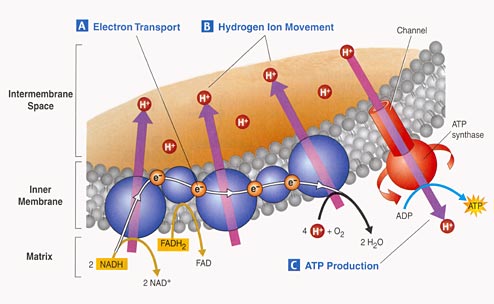Closed 12/22 Mr F.

Elements to ETC:
- NAD+
- ATP synthase
- 34ADP to 34ATP
- Enzyme mediate
- mitochondria
- chemiosmosis
- electron transport
- inner membrane space
- inter membrane space
- O2 is final electron acceptor

Cellular Respiration and the Electron Transport Chain
Regardless of whether the original form of energy is sunlight or food, it must ultimately be converted to the cellular energy currency of adenosine triphosphate (ATP). For most organisms, this conversion is accomplished though cellular respiration, a series of pathways in which glucose (sugar) is broken down and the energy extracted is converted to ATP. The pathways of cellular respiration include glycolysis, conversion of acetyl-CoA, Kreb’s cycle and electron transport. Electron transport is the most complex and productive pathway of cellular respiration, producing 34 molecules of ATP for every molecule of glucose.
Where the Electron Transport Chain Is Located
Electron transport requires a membrane in order to work. In prokaryotic cells, those of bacteria and bacteria-like Achaeans, electron transport takes place in the cell’s plasma membrane. In eukaryotic cells, the more evolutionarily advanced and complex cells of animals, plants and fungi, electron transport takes place in cellular organelles known as mitochondria—the eukaryotic cell’s tiny power factories.
How Electron Transport Works
Most of the ATP made in cellular respiration comes from the stepwise release of energy, through a series of oxidation-reduction (redox) reactions between molecules embedded in the plasma membrane (prokaryotes) or mitochondria (eukaryotes).
It is easiest to understand how electron transport works to divide it into three main events:
ETC works by using NADH that has been produced in previouse steps of the metabolic pathway, and using the electrons to create more ATP. This is done with electrons transporting hydrogen molecules through the membrane. By doing this there is a gradient created with a high concentration of hydrogen on the outside and a low concentration inside. Naturally, the hydrogen molecules will want to diffuse to create equilibrium. But the only way that they can get back in is through ATP synthase. As they go through, ADP turns into ATP which is used in the cells functions. A total of about 34 ATP are created in this process.
Now there are extra electrons stuck in between the membranes. Without anything to take them out, they will remain there and get stuck. This would be bad because if they get stuck, more electrons can't transport hydrogen, which means that they will be useless and 34 ATP won't be created. That is why oxygen is needed. Oxygen molecules are the final acceptors of electrons. They join with the electrons and remaining hydrogen molecules and are waste products. That is why oxygen is needed, and without oxygen, the process would end.

Though this diagram is simple i found it helpful. It clearly shows the parts of the mitochrondria the electron transport chain takes part in which i found helpful for the write up. It also shows how oxygen is used as the final electron acceptor to produce water which is important. The only thing that is missing is that it doesnt show ATP synthesis but this is the best diagram i could find because others go into depth about enzymes that we havent learned about yet.

The above diagram helped me figure out where the H+ gradient was, and how the etc looked in relation to the matrix/intermembrane space. It also helped me realize visually what was created and transfered in the chain.
In the mitochondrion, the MATRIX contains soluble enzymes that catalyze the oxidation of pyruvate and other small organic molecules.
The mitochondrial matrix also contains the mitochondria's DNA and ribosomes. The word "matrix" stems from the fact that this space is viscous, compared to the relatively aqueous cytoplasm. The cytosolic compartment has a water content of 3.8 μl/mg protein, while the mitochondrial matrix 0.8 μl/mg protein (Soboll S et al., in "Use of Isolated Liver Cells and Kidney Tubules in Metabolic Studies" pg 29-40, Academic Press, New York and London). It is not known how mitochondria maintain osmotic balance across the inner mitochondrial membrane, although the membrane contains aquaporins that are believed to be conduits for regulated water transport.
The following video guides you through the ETC and how it works.
http://www.youtube.com/watch?v=1engJR_XWVU&feature=related
A really good, step by step, visual guide of the Electron Transport Chain is linked below:
http://vcell.ndsu.edu/animations/etc/first.htm
The last stage of cellular respiration is the electron transport chain (ETC). The ETC uses the high energy electrons from the Krebs cycle to convert ADP to ATP. High energy electrons from NADH and FADH2 are passed into the electron transport chain. At the end of the chain there is an ATP synthase enzyme that channels hydrogen through the membrane which is used to create ATP.
Here is a video of a short lecture about the electron transport chain and about the krebs cycle coming from a college professor. It is always nice to hear a subject from a different teacher so this should help you.

Comments (0)
You don't have permission to comment on this page.